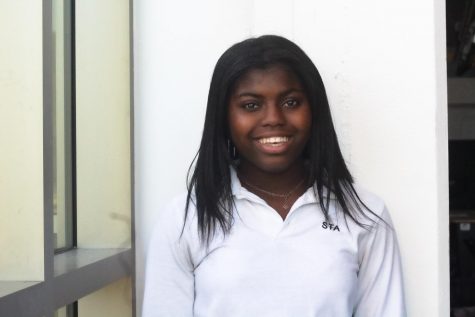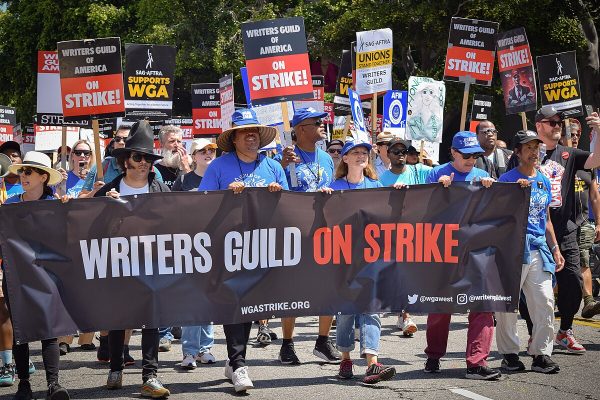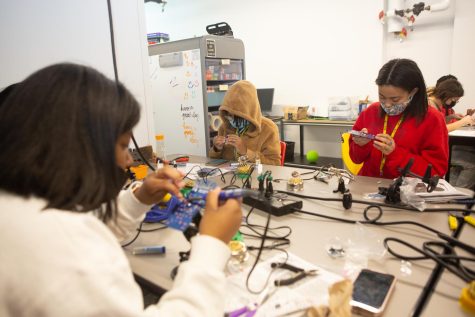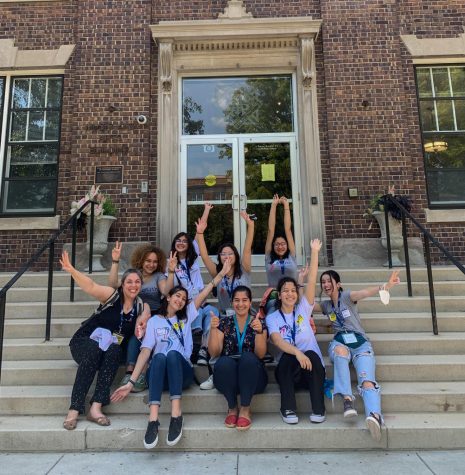Climate activists demand change
Students, teachers and concerned citizens all gathered Sept. 20 for a city-wide climate strike.
Protesters march at the Global Climate Strike Sept. 20. The march started at James A Theis Park and ended at the UMKC campus. photo by Anna Ronan
November 18, 2019
In Aug. 2018, a then-15 year old Greta Thunberg sat alone outside Swedish parliament, leaving school every Friday to strike for climate. One year and one month later, students, concerned parents and local activists across the world have joined her.
For senior Kailee Ford, it was Thunberg who first inspired her to speak out and become a climate activist.
“It was just her striking outside Swedish parliament with her sign, and that was it,” Ford said. “Then, it became 4 million people.”
The inspiration she gained from Thunberg, combined with her indignation about the state of the earth, pushed her into environmentalism.
“What really pushed me over the edge was the Amazon Rainforest fire,” Ford said. “It had been going on for two, three weeks, and we hadn’t heard anything about it. I just became so unbelievably angry.”
Ford’s passion about the destruction of one of the world’s largest ecosystems is one that has been felt around the world.
“This is a huge thing that’s supposed to help Earth thrive, and it’s being burned down,” Ford said. “I was like, ‘Okay, enough sitting around and thinking and being lost. I’m not lost anymore. I have a goal, and I want to get more involved.’”
Within STA, Ford is an officer and one of the creators of the Green Team, an extracurricular group that works with STA to create a more sustainable environment at school. Within the broader Kansas City community, Kailee is involved with the Sunrise Movement.
“I would like to see more smaller, environmentally conscious things like changing the more disposable items in the cafeteria,” Ford said. “That’d be nice, like maybe changing fruit cups to like a bowl of fruit and you dish yourself.”
According to their website, the Sunrise Movement’s goal is “building an army of young people to stop climate change and create millions of good jobs in the process.”
It was with Sunrise that she was able to speak at Kansas City’s walkout Sept. 20.
“I wanted to make my voice heard, because I think that’s very important, you should always tell your story so that people can understand,” Ford said. “And that’s where I met Sunrise Movement, the Kansas City chapter of it.”
Ford’s original idea was to organize an STA walkout, not connected to a city-wide strike. She was unsure if any organizations were conducting a Kansas City walkout but knew she wanted to advocate for the acknowledgment of a climate emergency.
“The Earth has gone through changes of heating and cooling tons of times, thousands and billions of years ago,” Ford said. “But it’s been growing rapidly within the last few decades. We do know that is due to human activity.”
As she stepped onto the podium under the bright sun at Frank A. Theis Park, this indignation is what drove her.
“To our political leaders: Mayor Quinton Lucas, Congressional Representative Emmanuel Cleaver, and to President Donald Trump and all other politicians,” Ford directed. “The time to act is now. We aren’t going to let you get away with ignoring the warning signs anymore. We have to work together. You must listen to science now.”
She not only addressed the role of students such as herself but acknowledged the disproportionate effects climate change has on lower-income communities and people of color within those communities.
Justice Horn is the student body president of the University of Missouri Kansas City, and spoke at the walkout. As a black person, and member of the LGBT+ community, he believes in the importance of intersectionality as it relates to environmental activism.
“I love that young people are getting involved, no matter if it’s LGBT rights, women’s rights, reproductive rights, civil rights and even climate change,” Horn said. “It doesn’t matter how old you are, if you’re fighting the good fight. I think that’s absolutely amazing. That’s what we’re seeing.”
Horn’s introduction to climate activism was inspired by the disproportionate effects natural disasters have on marginalized communities. According to the Centre for Research on the Epidemiology of Disasters, on average the death toll per disaster in low-income countries was five times more than in high-income countries.
“When things really get bad, it’s going to affect low-income communities and communities of color,” Horn said. “You see it in Puerto Rico. You see in the Bahamas. Communities that don’t have resources are up and wanting to hunker down and rebuild. These are the communities that suffer.”
Although the communities most affected are people of color and low-income populations, Horn stresses the importance of all communities gathering in allyship.
“Although I’m an ally when it comes to a lot of things like this, there’s a time to be a part of a movement, but then there’s a time to step aside,” Horn said. “I’m happy that people, if need be, are stepping aside for communities to have a seat at the table. So I think that I mean, that’s not only my experience as a person of color, but also being in the LGBTQ community, I’m a double minority in America.”
Within the population of STA, there are many ways to get involved. According to science teacher Sarina Farb, the most effective method is changing our dietary habits.
“There was a report that came out in a journal last year that basically said the most impactful thing every individual can do is cut meat and dairy out of their diet, for our personal carbon footprint and environmental footprint in general,” Farb said.
Farb’s activism is largely focused on dietary choices and shifting consumer mentality away from supporting the meat and dairy industries. Within the city and national area, Farb is involved with many climate activism groups, such as Climate Healers and Kansas City Vegans for Change. She was also emotionally moved by the Amazon fires.
“With a lot of the indigenous people in the Amazon, when the fires got a lot of attention a couple weeks ago, the number one thing they were calling for was for people to shift their demand away from meat, because the global demand for meat is driving cattle grazing in the Amazon,” Farb said.
According to the Food and Agriculture Organization of the United Nations, “Beef and cattle milk are responsible for the most emissions, respectively, contributing 41 percent and 20 percent of the sector’s overall GHG outputs.” GHG are greenhouse gases, which include carbon dioxide and methane.
Although people can limit their meat and dairy consumption, Farb recommends that consumers should also encourage the government to stop subsidizing the meat and dairy industry.
“We’re hugely subsidizing those industries, and giving them monetary incentives, even as consumer demands start shifting,” Farb said.
The systems that be may be able to drive major change, such as reducing subsidies on meat and dairy farms, or fiscally encouraging eco-friendly businesses. However, Ford believes in the importance of encouraging other young people to get involved on a local level as well.
“It’s time to be assertive, it’s time to be demanding,” Ford said. “We need to demand that they listen to us, that they listen to science.”











